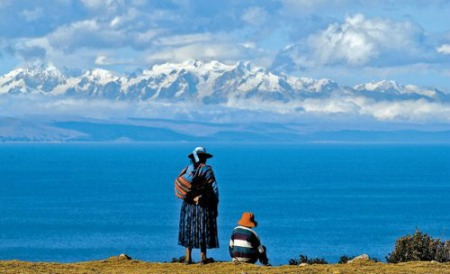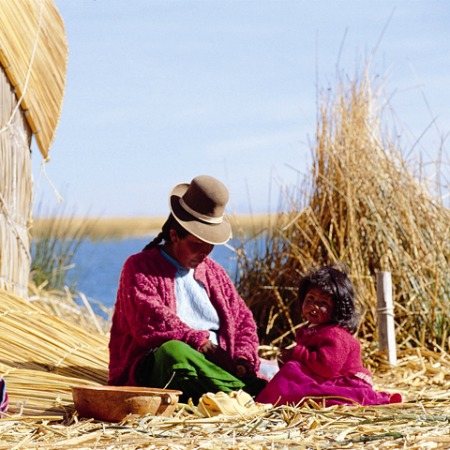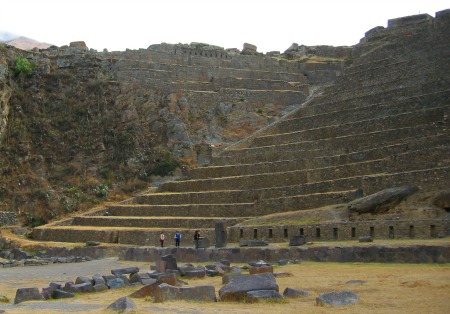Lima, Cusco/Machu Picchu + Lake Titicaca - 7 - 9 Day Tours
|
|
Here are 2 tours that include Lima, Cusco/Machu Picchu and Lake Titicaca. Pricing is with group or private day tours. It can be modified to suit your interests, such as if you arrive to Lima in the morning, want private day tours, more days and day tours, etc. We can also add on extensions to the Amazon and other areas. Flights are not included in prices.
|
7 Day Legacy of the Inca EmpireDAY 1 | ARRIVAL LIMA
Arrival at Lima Airport. You will be met at the airport at the scheduled time to transfer you to your hotel in Lima.
DAY 2 | LIMA – CUSCO: CITY TOUR AND ARCHAEOLOGICAL SITES You will be transferred to the airport to take the flight to Cusco (it is suggested to book a flight arriving before 11hrs). Once in the city, a transportation service will take you to your hotel. Then, enjoy a guided tour of the former capital of the Inca Empire. The tour starts with a visit to Santo Domingo Convent, a large Renaissance-baroque complex, which was built over the Inca Coricancha temple. It was one of the most important temples dedicated to worshiping of the sun, and its foundations are still prominent at the base of the convent. Ancient chronicles say the temple was covered in gold leaf and filled with golden representations of nature. Then, visit the Cathedral, the most imposing monument of the Main Square. Head to the hills above Cusco to visit the remains of the fortress of Sacsayhuaman, whose impressive ramparts offer a stunning panoramic view of Cusco, and the ruins of the temple and amphitheater of Qenqo, where it is believed the Incas practiced agricultural rituals. Admire Qenqo and then finally visit Puka Pukara (‘Red fortress’ in Quechua) an Inca military complex located on a prominent hill. Its dwellings, squares, bathrooms, aqueducts, walls, and towers can still be appreciated. Afterwards, return to your hotel.
DAY 3 | CUSCO – SACRED VALLEY: CHINCHERO, LIVING MUSEUM OF YUCAY AND OLLANTAYTAMBO During the morning, you are picked up from your hotel to visit the town of Chinchero, a traditional Cusco urban centre located at an elevated point with a beautiful view of the valley. The inhabitants of this area preserve the artisan traditions and the inherited knowledge of the Incas and display them in their clothes and customs. In Chinchero there are also archaeological remains and a beautiful seventeenth-century church, one of the first Catholic buildings in Peru. Then, you are transferred to the Living Museum of Yucay, an Andean tradition interpretation centre with demonstrations of the production of textile work, adobe, pottery and silverware, following the techniques used by the ancestors. Also, residents of the museum include llamas, sheep and alpacas, and they can be fed! Visit the town of Ollantaytambo upon your arrival - inhabited uninterruptedly since Inca times - and have a superior Andean gastronomy experience in a restaurant. Fell the true spirit of the Sacred Valley, transmitted in a cosy atmosphere! Later, climb the iconic fortress, built next to a mountain and then you are transferred back to your hotel. *On Sundays, also visit the local market.
DAY 4 | SACRED VALLEY - MACHU PICCHU – CUSCO You will be picked up and transferred to the Ollantaytambo station to board the train to Aguas Calientes, the nearest town to Machu Picchu. Take the train to Aguas Calientes, travel observing the Andean landscapes during a journey of an hour and a half. Our guide will be waiting for you and will accompany you until the departure point of the bus. Afterwards, take a bus for the 25-minute journey up to Machu Picchu, known as the "Lost city of the Incas". After completing the tour, you will take the bus to Aguas Calientes, where you will enjoy lunch at your selected restaurant. Following lunch, you can explore the charming village and, when you're ready, board the train back. The trip by train will take an hour and a half and it will take you back to Ollantaytambo, where our transportation will accompany you back to your hotel in Cusco. *Lunch time could vary depending on the entrance to the citadel. **Due to the citadel’s limited capacity we recommend that you confirm your booking as soon as possible to proceed with the tickets purchase. Tickets are subject to availability.
DAY 5 | CUSCO – PUNO Enjoy a leisurely breakfast at the hotel then transfer to the bus station to start your journey through the impressive landscape of the Andes to Puno. Your first stop of the day is in Andahuaylillas, a town located around 40 kilometres away from Cusco. The main attraction here is the local Church, known as the “Sistine Chapel of America” owing to the high quality of art found inside. Continue the journey to Racchi, home to the Wiracocha Temple, a striking rectangular structure measuring 30 metres wide and 20 metres high. Lunch will be taken in the town of Sicuani before you head to La Raya, the highest point of the trip between Puno and Cusco, at the dizzying altitude of 4,313 metres above sea level. The next stop is the town of Pucara, the first urban settlement on Lake Titicaca, established between 100 and 300 A.D. Visit some of the monoliths from the town’s pre-Inca site at the Pucara Lithic Museum before completing the final part of the journey to Puno. Once in the city, a representative will check you into your hotel.
DAY 6 | PUNO – LAGO TITICACA: UROS AND TAQUILE After breakfast at the hotel, travel to the port of Puno where a boat will be waiting to take you to the beautiful Uros Islands. The Uros are an indigenous people of Peru that live on a series of human-made islands, created entirely from the buoyant totora reeds that grow abundantly in the shallows of the lake. The islands are composed of layers of woven totora, which are regularly replenished from the top as they rot from the bottom. The Uros people also use reeds to construct their homes, so cooking is done outdoors to avoid possible fires! After visiting this fascinating island, sail to Taquile, a small slice of heaven that once belonged to the Inca Empire. Look around and notice traces of its Incan past in the ruins that still exist around the island. After a brief introduction, the local community will give you an insight into their customs and traditions with a cultural demonstration. Lunch is enjoyed on the island before the return trip to Puno.
DAY 7 | PUNO DEPARTURE After breakfast at the hotel, you will be taken to the airport of Puno to take your departure flight.
Price per person in US$ for 2024:
|
9 Day Andean ExperienceDAY 1 | ARRIVAL IN LIMA
Arrival at Lima Airport. You will be met at the airport at the scheduled time to transfer you to your hotel in Lima.
DAY 2 | LIMA – LARCO MUSEUM & CITY TOUR Start with the Larco Museum, located in the traditional Pueblo Libre district, which is housed in a beautifully restored viceregal mansion built on a pre-Columbian pyramid. The museum boasts the world’s most complete pre-Hispanic collection of gold and silver objects, as well as pieces of erotic art. Then visit Casa Aliaga, a colonial mansion granted in 1535 by chief conquistador Francisco Pizarro to Jeronimo de Aliaga, one of his captains. This is the only house from that time that to this day has always been owned by the same family. Continue to a scenic tour in the colonial downtown, which originates and spreads out from the Main Square. Here you can appreciate the grandiose architecture of the Spanish Empire and be amazed by Lima´s Cathedral. Erected in the 16th century, this building took more than 80 years to complete. After the tour, you’ll be transferred back to the hotel.
DAY 3 | LIMA – CUSCO / CITY TOUR AND NEARBY ARCHAEOLOGICAL SITES As on day 2 of 7 day tour
DAY 4 | CUSCO – SACRED VALLEY: CHINCHERO, LIVING MUSEUM OF YUCAY AND OLLANTAYTAMBO As on day 3 of 7 day tour
DAY 5 | SACRED VALLEY – MACHU PICCHU You will be picked up from your hotel and transferred to the Ollantaytambo Station to board the train to Aguas Calientes, the nearest town to Machu Picchu. Take the train to Aguas Calientes, observing the Andean landscapes during a journey of an hour and a half. Our guide will be waiting for you and will accompany you until the departure point of the bus. Afterwards, take a bus for the 25-minute journey up to Machu Picchu, known as the "Lost city of the Incas". After completing the tour, you will take the bus to Aguas Calientes, where you will enjoy lunch at your selected restaurant *Lunch time could vary depending on the entrance to the citadel. *Due to the citadel’s limited capacity we recommend that you confirm your booking as soon as possible to proceed with the tickets purchase. Tickets are subject to availability.
DAY 6 | MACHU PICCHU – CUSCO Today, you can optionally return to Machu Picchu (at extra cost for ticket). You may discover the views from Huayna Picchu, which is about 360 metres above Machu Picchu with an underground temple complex; and from Inti Punku, which offers even better views from about 390 metres above the citadel. Another option is the Inca Bridge, a secret military trail, which controls access to the citadel. In the afternoon, transfer to the Aguas Calientes station and take the train back to Ollantaytambo station. From here you will be transferred to your hotel in Cusco. **Kindly remind to purchase your tickets before your trip due to the limited capacity of the citadel. Entrances are subject to availability.
DAY 7 | CUSCO – PUNO As on day 5 of 7 day tour
DAY 8 | PUNO: UROS AND TAQUILE ISLANDS As on day 6 of 7 day tour
DAY 9 | DEPARTURE PUNO After breakfast at the hotel, a transportation service will take you to Puno’s airport for your departure from the city.
Price per person in US$ for 2024:
INCLUDED ON BOTH TOURS
|




